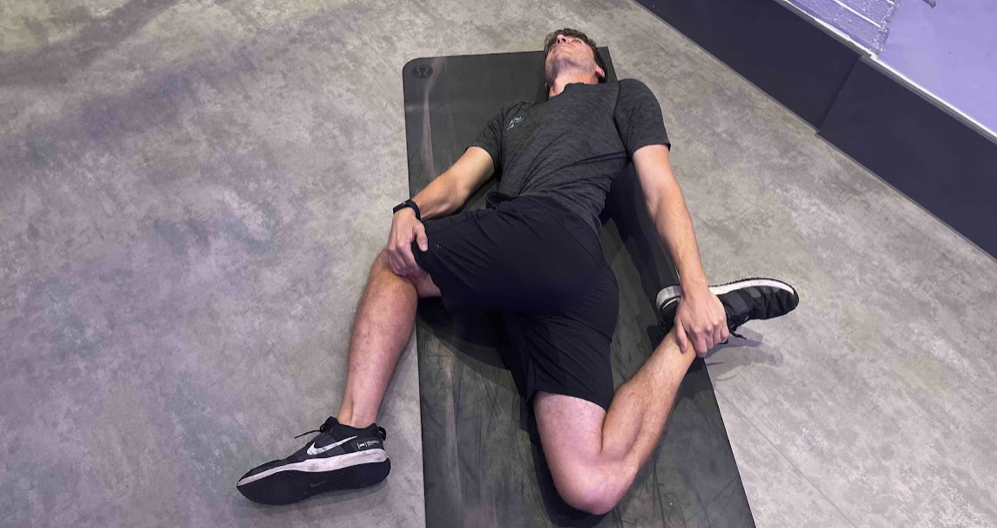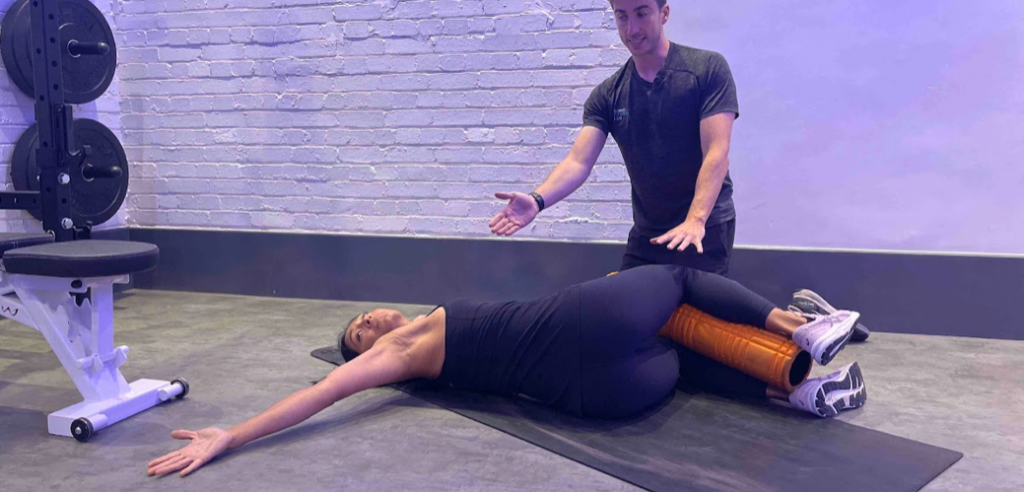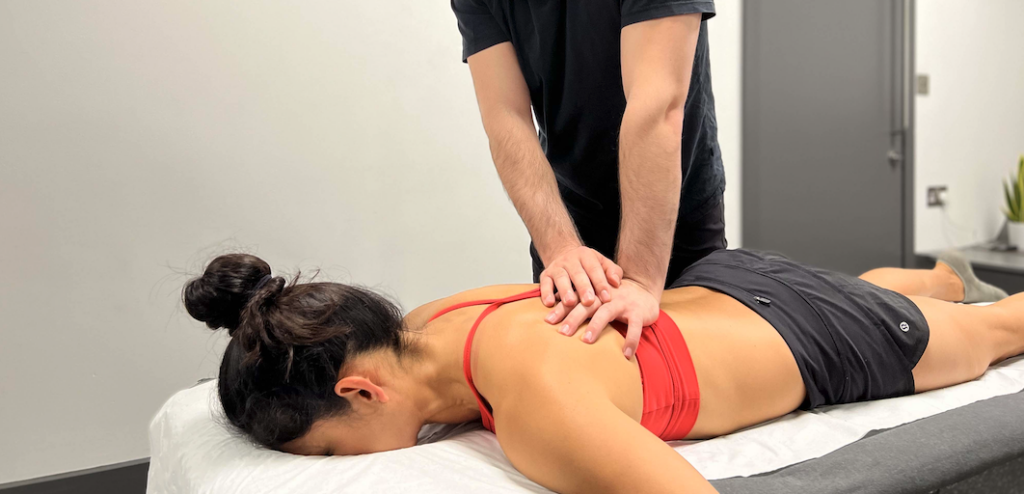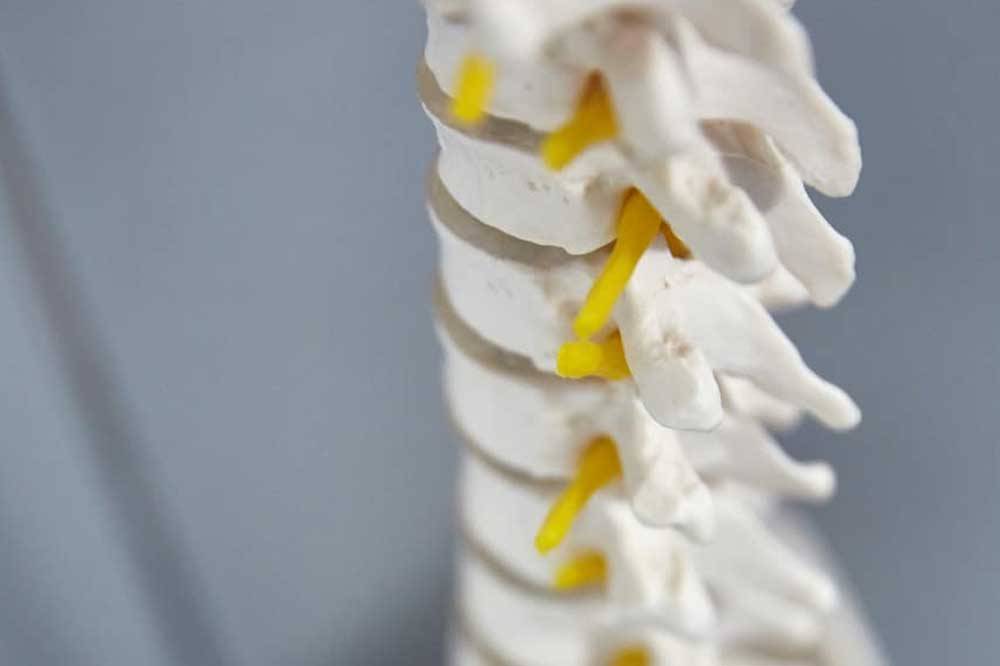Our specialist area is making people stronger, healthier, and more mobile – but we’re often asked what’s caused pain or weakness issues in the first place.
Since back pain is one of the most common pain issues, we’ve decided to take a detailed look at the ‘thoracic spine’ – as it plays a foundational role in all shoulder and arm movements.
Adequate thoracic spine mobility is key for upper and lower body function. Poor T-spine mobility may be the root cause of shoulder, neck, and back problems.
What makes up the thoracic area?

Your thoracic spine sits below the cervical vertebrae in your neck and above the lumbar vertebrae in your lower back. It should be able to move forward, backward, and side to side, as well as rotate.
The muscles of the thoracic region can be arranged into 3 categories:
- Superficial muscles, found just under the skin and visible in lean individuals. These muscles include the latissimus dorsi, the trapezius, levator scapulae and the rhomboids.
- Intermediate back muscles, these elevate and depress the rib cage. There are two major muscles within this category the serratus posterior superior and the serratus posterior inferior.
- Finally the Erector Spinae and Transversospinalis Group (intrinsic back muscles). These aid in movement of the vertebral column and help control posture.
What are some causes of thoracic pain?
Pain in the thoracic regiuosn is normally related to poor posture or myofasical muscle pain or tension.
Some common causes are:
- Sitting or standing in a forward head or slouched posture for extended periods
- A lack of muscular strength
- Overuse injury
Be aware, this list is not exhaustive list and should not be treated as a diagnostic, rather these are some likely/common causes.
Stretches to help thoracic pain
Stretching a stiff thoraicc spine may help provide some temporary relief and may be effective in improving short term mobility prior to a workout, however it will not act as a long term fix. In order to avoid thoracic pain, a combination of strengthening the thoracic region and amending lifestyle factors will be more effective.
T Spine Bench Stretch
This can help loosen the upper back stiffness that can come with a slouched ‘desk posture.’ It will hit the muscles of your upper back and rear delts as well as the lats and triceps.
Take a full kneeling position with a bench 1-2 feet in front of you, depending on the length of your arms. Take hold of a dowel, pvc pipe or similar with both hands, keeping your palms facing your body. Place your elbows on the edge of the bench and sit your glutes back towards your ankles. Keep your knees under your hips to avoid arching your lower back and avoid letting your head drop.
Brettzel Stretch

In terms of bang for your buck, this is one of the most effective stretches out there. It’ll hit your lower back, hip and quad while improving thoracic mobility.
Lie on your side, with the knee of the leg that’s on top bent. Your knee should be about in line with your belly button, the other down in a neutral position. Take hold of your bent knee with the arm on the floor, reaching under the leg and gently pull it towards the floor. Take hold of your other ankle with your other hand and pull the sole of your foot towards your glutes. If you don’t have the mobility to do this you can use a towel or ankle strap.
With each exhalation, rotate your shoulder away from your top leg.
Dynamic Thoracic Openers
This can be used as a means of increasing thoracic spine mobility and opening up the upper back before an upper body workout.
Lie on your side with one knee propped up on a block or foam roller and the other leg outstretched. Place your hands together on the floor in front of you. Under control, bring one hand towards the floor on the opposite side.

Ensure you’re rotating through the upper back and not the shoulder. Keep your knee fixed to the foam roller or block, as soon as it starts to lift, that’s a sign you’ve hit the end of your range of motion, and any further movement will come through compensations in the lower back.
Dynamic T Spine Mobilisation
Set up in the same way as the T Spine Bench Stretch described above- take a full kneeling position with a bench 1-2 feet in front of you, depending on the length of your arms. Take hold of a dowel, pvc pipe or similar with both hands, keeping your palms facing your body.
Place your elbows on the edge of the bench and straighten out your arms. To perform the movement, sit your hips back towards your ankles while simultaneously curling your hands towards your head, keeping your elbows in contact with the bench. Ensure you’re in full elbow flexion in the bottom position and maintain a neutral head position. Brace your core throughout and focus on extending through your upper back and flexing through the shoulders.
Exercises to help thoracic pain
The following exercises are likely to be included in a programme that has a focus on thoracic strengthening and mobility:
Thoracic Spine Extensions on a Physioball
A T-spine extension flexes your spinal erectors to lift your back upward. To perform, kneel in front of an exercise ball and place your stomach on it. Place both hands behind your head and allow your chest to sink forward. Now, flex your entire back and raise your chest off of the ball. You’ll feel your lower back activate — hold that position for a few seconds, then lower yourself back down.
Seated Face Pull to Z-Press
The seated face pull is a great corrective posture exercise for a couple of reasons because it forces you to work important posture muscles from a seated position. When you’re seated on the ground, your postural muscles are already working to keep you upright.
Loop an exercise band around a pole or a squat rack. Sit down on the floor, about two feet away from the band’s anchor point. Place both of your wrists inside one end of the band and spread your arms apart, so they make a “W.” Now, extend them forward and then pull them back, keeping your arms bent at 90 degrees. Once the band is right in front of your face, press your hands up.
Half-Kneeling Single-Arm Cable Row
The half-kneeling single-arm cable row addresses two key components of posture. By starting in a half-kneeling position, one can stack their ribs over their hips, creating better postural alignment.
Adding the row on the cable machine creates an element of rotation that forces the body to stabilize throughout the movement. Not to mention, you’re also strengthening and targeting your back muscles.
Attach a handle to a cable pulley and set it to about mid-height. Grab the handle in one hand and step back about one foot. Kneel, keeping your torso upright. The knee opposite the arm holding the handle should be up. Row the handle to your side until your elbow passes your torso, ensuring your shoulder does not roll forward, and then switch hands and knees.
Treatments to help thoracic pain

Massaging the area around the thoracic region may provide some temporary relief, as with the stretches above it is not a long term fix.
The causes of your thoracic pain are likely to be unique to your individual circumstances, therefore an expert physio will be able to diagnose the root cause and provide a plan to improve the issue.
In the long term, working with a qualified personal trainer to strengthen the area is your best bet.
Avoiding thoracic pain going forward
There are 3 key areas to address to avoid thoracic pain going forward.
First of all, strengthening the areas around the thoracic region, there are myriad movements to strengthen this area. The examples given above are just a select few.
Secondly, and linked to the first area, is correcting lifestyle factors. This will include sitting in the same slouched or forward head posture for extended periods. As the areas of the thoracic region get stronger, this will become easier.
Finally, establishing proper breathing function. The primary muscle controlling our breathing should be the diaphragm, a powerful dome-like muscle inside our chests. Our breathing pattern should be slow, deep, and rhythmic, following a path from nose to belly.
Unfortunately, this path is often derailed by the stresses of modern life.
These stresses can shift our breathing pattern away from our stronger lower ribs and towards the weaker upper ribs. This breathing pattern is designed for use in extreme circumstances (e.g when we’re being chased by a predator!) and leads to shallower, shorter breaths.
Shallow breathing means we take in enough oxygen but excrete too much carbon dioxide. This leads to changes in posture of the head and neck, clenching of the jaw, grinding of the teeth and can even negatively impact cognitive function. Taking the time to focus on diaphragm breathing will pay dividends in preventing thoracic pain long term.
Keen to hear more about the thoracic spine and how we’d build these kinds of exercises and stretches into a personalised programme? Why not get in touch!

